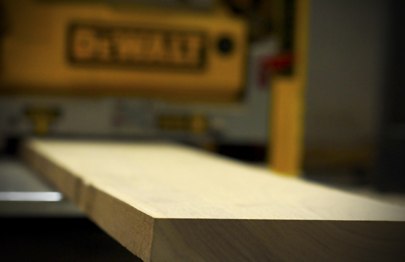We may earn revenue from the products available on this page and participate in affiliate programs. Learn More ›
The thickness planer is not the most versatile tool in your arsenal. In fact, it really only does one thing: it planes things to a consistent thickness, as its name suggests. It’s definitely not a tool you wanna buy before a compound miter saw, or even a table saw. But once you’ve learned what it can do, or get one into your garage and basement, you’ll wonder, “How did I ever do without this?”
Read any fine woodworking handbook or magazine, and it’ll extol the virtues of the thickness planer as a way to thicken wood stock so that it possesses an even height throughout its length. They’ll note that it does not flatten stock nor remove the natural warping or twisting along its length—that’s the job of the jointer. This means two things: that the consistent thickness allows you to have perfectly matched, airtight joints across a project, and that you can save money by buying less expensive rough-cut lumber and planing off the surface at home (instead of paying the lumber mill to do that work for you).
And that’s all well and good for woodworkers building custom furniture or doing fine detail work, but what does it mean for the average weekend warrior interested in learning to do things themselves? Why, plenty, of course.
Using reclaimed wood. With fresh lumber becoming increasingly expensive, finding old wood from barns, decks, fences, and rehabbed housing has become a popular option in the last few years. The patina and well-worn surface of reclaimed wood is unmatched, and once you’ve removed any metal fasteners, the thickness planer is the way to go to get it usable again.
Cleaning up glued up blocks. If you’re interested in making anything via a glued-up panel, such as countertops, cutting boards, carving or hobby projects, no matter how careful you are, the joints are never perfectly flat with all that wet glue slipping around. The planer makes quick work of flattening surfaces, saving you hours of sanding.
Repurposing scrap wood. (My favorite use!) My uncle works for a hardwood flooring company, and they have pounds and pounds of perfectly usable scraps of walnut, maple, oak, Brazilian cherry, ash, and other beautiful hardwoods. They typically just end up in the firewood pile (walnut! as firewood?!), but with my planer, I can shave off the grooves in the back, and have perfectly usable hardwood for whenever inspiration strikes.
Sizing baseboard or molding. If you ever need to shave off an 1/8″ on baseboard, just send it through the planer and be done in 2 minutes. Try doing that with a belt sander.
Save money on home center lumber. At the home improvement store, select grade pine can go for as much as $2.00 a board foot. Inexpensive dimensional lumber, like a 2×4″? About $.25/bd. ft. Meaning? With a few swipes through the thickness planer, you can take off the rounded edges of framing stock, creating a squared length perfect for architectural details, faux beams, and finish trim. Last autumn, I created a bench out of cedar decking material, which I cut to size and milled with my planer. If I had bought the wood already sized, I would have spent almost $200… if I could even find enough straight cedar 1x2s. Instead, I spent only $70 on wood, and spent just an hour milling it to size.
For more on hand and power tools, consider the following articles and slideshows:
The Jointer
Quick Tip: Tool Maintenance
Chain Saws 101
In Search of Antique Tools

